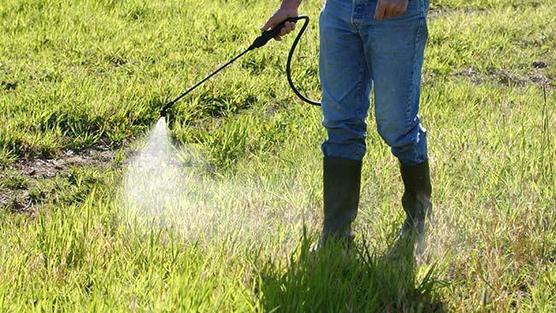TEHKUMMAH—A large contingent of people from across Manitoulin gathered at the August monthly meeting of Tehkummah council last week to support Tehkummah resident George Kopylov in his bid to see the end of herbicide spraying in his municipality, and with much success.
Mr. Kopylov noted that the first time he became aware of any potential for herbicide spraying in Tehkummh was through a notice posted in the July 12 edition of this newspaper by the Ministry of Transportation (MTO).
“It says that pesticides will be applied, and I quote, ‘starting 250 metres west of Hwy 542A and then northerly for 10.11km’,” Mr. Kopylov addressed reeve and council. “Where is this, exactly? If you look on a map, 250 metres west of Hwy 542A lands you in the middle of a field, and if you go north from there you’d have to cross some pretty rough ground. The location of the spraying is extremely vague. Next issue, the date of application, July 15 to August 15. The notice was posted on July 12. This was a three-day notice. According to the Pesticide Act and Regulations, Part V, and Reg. 309, a minimum of 10 days’ notice must be given. This notice was one week late, per the law.”
The pesticides mentioned in the notice were Clearview, Weedaway Dichlorprop DX and Hasten Adjuvant. Clearview, Mr. Kopylov shared, is highly toxic to fish and aquatic life, according to its own Material Safety Data Sheet (MSDS), issued in 2016. “Spills into natural waterways are likely to kill aquatic organisms,” he read. “In other words, it kills fish and everything else that lives in water. This is a scientifically proven fact. Prevent (Clearview) from entering soils, ditches, sewers, waterways and groundwater. No data is available on whether it dissolves in water. We simply don’t know.”
Mr. Kopylov continued by noting that Clearview is also classed as a Group 2B carcinogen: possibly carcinogenic to humans. “In other words, it causes cancer. Maybe, just maybe. We simply don’t know for sure…yet. Do we want to find it out the hard way, in 20 years?”
The MSDS goes on to state that it is not known if Clearview is bio-degradable, but what is known is that its potential mobility in soil is very high. “How can one be known and the other not?” he asked reeve and council.
The MSDS for Weedaway states the following: ‘Do not contaminate irrigation ditches and domestic water supplies. If this happens, call police.’ “Why?” Mr. Kopylov asked. “The MSDS does not explain. I have called Mindemoya OPP to find out what they are going to do if somebody calls them about this pesticide spilling into waterways. According to Sergeant Minnear, they won’t do much. Send out an officer to look at it, if one is available, take information of the parties involved and start a ‘mini-investigation.’ He referred me to the Spill Action Centre of Ontario. I called them. ‘Has the spill occurred?’ they asked. ‘No,’ I said. ‘Well then,’ they responded, ‘there is nothing I can tell you because every spill is unique and we can only decide on the actions to take after the spill has occurred.’
“Is this the level of preparedness we are okay with?” Mr. Kopylov posed the question. “Wait until an accident happens and then see what we can do about it?”
Weedaway, he added, is also labeled as a Class 2B carcinogen. “Causes decreased fetal body weights and delayed development in the offspring of laboratory rats,” he read from the MSDS. “Basically, rats that were exposed to Weedaway had small and misdeveloped litters. What about humans? We are not lab rats. No long-term studies on humans have been done. This, of course, is nearly impossible to achieve in an ethical society. Also, the variation in cancer patients makes it extremely difficult to pinpoint the exact cause of any cancer. Therefore, we must not confuse ‘possibly carcinogenic’ with ‘unlikely carcinogenic.’ Do we want to experiment with the health of our grandchildren and their children’s children?”
Weedaway’s active ingredient is 2,4-D. “According to Cornell University’s Pesticide Management Education Program, it was a major ingredient of Agent Orange (about 50 percent),” Mr. Kopylov shared. “Agent Orange was a herbicide widely used during the Vietnam War. The Vietnamese are to this day dealing with horrible consequences of this monstrous crime: birth defects, extremely high rates of cancer, high infant mortality. This is what it looks like in real life,” he added, sharing pictures of children with birth defects that are still plaguing the people of Vietnam.
Mr. Kopylov also shared with the reeve and council an article that appeared in this newspaper in November 2015 regarding Cold War veteran Jim McDonald’s daily struggle in living with the after effects of being exposed to Agent Orange while stationed at Gagetown, New Brunswick.
Moving on to the Hasten Adjuvant, Mr. Kopylov explained that its MSDS clearly says “to prevent runoff into drains and waterways,” but offers no more information.
Mr. Kopylov reminded council of Manitoulin Island’s unique fractured limestone features, which causes water to travel great distances underground—the same water we all rely upon for our drinking water.
“Do we want to endanger our most precious natural resource—our drinking water?” he asked. “Is vegetation control worth the risk of getting cancer, even the slightest birth defect, or contaminating our rivers and lakes? Do we want to be the “long-term study” subjects on the effects of such practices?”
One Tehkummah resident spotted the MTO’s contractor, DBI, spraying the herbicide on the east side of Hwy 542 on July 25. The next day it rained heavily and, for council’s benefit, Mr. Kopylov shared a video with them he had taken of the downpour.
Mr. Kopylov noted that he had called the number listed in the newspaper notice and had spoken with a Mr. McIntyre at the MTO on July 27. “He could not answer my question about what vegetation is being targeted and why,” Mr. Kopylov said. “‘It’s probably just poplars and brush,’ he said, and then added, ‘Don’t worry, we are not doing any spraying in Tehkummah.’ Now, this was simply not true. When I told him that I have evidence of the spraying being done the day before, he claimed to know nothing about it. Then I asked him, ‘Can you confirm that Clearview is meant to be applied before the plants flower?’ He said, ‘Yes, in an ideal world, it is, but in reality, we do what we can.’ He did not comment on why it was being applied in late July. He also could not comment on why Hwy 542 was the only place on all of Manitoulin that needed to be sprayed.”
“What will our grandchildren say when they learn about our careless attitude to this beautiful, fragile environment and our (and, more importantly, their) water?” Mr. Kopylov asked. “How much more difficult is it to simply cut the vegetation down on a regular basis, like it has always been done?”
Following his presentation, Mr. Kopylov asked council for four things: 1. Request a cost-benefit analysis from the MTO on spraying versus cutting the vegetation mechanically along Hwy 542; 2. Request that MTO mails letters out to people in Tehkummah whose properties are immediately affected by future sprayings; 3. Request from the MTO, for public perusal, a written explanation on why the spraying was implemented, what vegetation was targeted and why, what chemicals were used and how much of them, why the spraying was restricted to this specific area, and who are the relevant stakeholders and participants involved in the implementation of this spraying; and 4. Condemn and strongly oppose the use of these dangerous chemicals in the future.
The crowd erupted in applause following the deputation.
“My impression of what was going to happen is that I truly believed that people would have been notified,” said Councillor Paul Bowerman, adding that he spoke with the person who had seen the spraying who informed him that the application took place on a stretch of roadway with no major vegetation issues.
“I think we were duped into thinking everyone knew about this,” the councillor added.
Mr. Kopylov explained that in 2008, the Ontario government passed the Cosmetic Pesticides Ban Act which effectively took away a municipality’s rights to stop provincially mandated spraying. (There is, in fact, a petition being circulated on Manitoulin in regards to this now.)
Councillor Laird Lee suggested asking the MTO for a follow-up on the spraying, asking how much herbicide was used, when and where, as this must all be carefully documented.
One audience member said that the active ingredient 2,4-D has a buffer zone for ditches. Councillor Lee said that everything depends on the quantity used.
“But it kills fish,” Mr. Kopylov said.
“So does chlorine but we drink it every day,” Councillor Lee countered, adding that the chemicals we surround ourselves with each and every day all have the potential to do horrible things, but only at certain levels.
Mr. Kopylov asked Councillor Lee if he was okay with using small amounts of chemicals rather than manual brush cutting. Councillor Lee said he was not, but would like to see the cost analysis.
“This spray should not be used until we have the proper information,” Councillor Ron Hierons added.
Boo Watson suggested having all Tehkummah residents contact the MTO to have their named added to a ‘no spray zone’ she found out can exist after contacting MTO Minister Steven Del Duca about the Tehkummah situation and her market garden located near the highway.
“It seems clear to me that this is an experiment, not a control measure,” she added, noting that the swath of vegetative control was too small to be effective for anything other than a study.
“I think that you as a group caught them with their pants down,” Councillor Bowerman commended the group.
Council then passed the following resolution, moved by Councillor Lee, seconded by Councillor Hierons: “Whereas the residents of the Township of Tehkummah have presented concerns regarding the Ministry of Transportation herbicide spraying program with the Township of Tehkummah; and whereas the council for the Township of Tehkummah deems these concerns to be valid and representative of the municipal residents, be it resolved that the Ministry of Transportation be advised that the Township of Tehkummah is to be deemed a ‘no spray zone’ for herbicide spraying effective immediately; and that the clerk-treasurer shall research and draft the appropriate policy which will address and enforce this restricted use zone’ and that this municipal council contact the Ministry of Environment for a report of the spraying program carried out in Tehkummah by DBI under MTO direction.”
Again, more claps and cheers were heard from the audience.




